Rib fracture - violation of the integrity of the paired arcuate bone (one or more) forming the chest. Home treatment is carried out according to an individually selected scheme. Timely appeal to a medical institution helps to prevent the development of complications.
Record content:
- 1 Views
- 2 Stages and degrees
- 3 Symptoms
- 4 Reasons for the appearance
- 5 Diagnostics
- 6 When to see a doctor
- 7 Prophylaxis
-
8 Treatment methods
- 8.1 Medications
- 8.2 Traditional methods
- 8.3 Other methods
- 9 Possible complications
- 10 Rib fracture video
Views
A rib fracture, for which home treatment involves medication, is classified by origin.
There are several main types:
| Classification | A type | Description |
| Clinical condition | Unstable | A fracture is characterized by helical or oblique lines (fractures). Secondary displacement and contraction of muscle tissue is possible. |
| Stable | The fracture line is transverse, no displacement is observed. | |
| Number of fractures | Multiple | As a result of the injury, the integrity of several bones was compromised. |
| Unit | A fracture of one rib was revealed. | |
| Localization of injury | Bilateral | Bones are damaged on the left and right sides. The risk of breathing problems is high. |
| Unilateral | The ribs are damaged on one side (only on the left or only on the right). | |
| Damage degree | Crack | After a mechanical injury, a crack forms on the rib. |
| Subperiosteal | Bone tissue damage is observed. | |
| Full | The flat bone is damaged throughout its thickness. | |
| Bias | No bias | Standard type of fracture. The shards are not displaced. |
| Secondary displaced fracture | The displacement of the fragments is caused by the contraction of muscle tissue. | |
| Displaced primary fracture | The displacement is due to traumatic factors (impact force, angle of incidence). | |
| Defect location | Epiphyseal | Fracture of the intra-articular type. Fracture in whole or in part falls on the joint cavity. Fixation of the bone in this case is required. |
| Metaphyseal | The fracture occurs in the tubular bones, the joints are not subjected to deformation. | |
| Diafezarny | ||
| Rib fracture direction | Impaled | Bone fragments form in almost every type of fracture. Their number directly depends on the type of damage: with triple - 4 fragments, with double - 3 fragments, with standard - 2. If during a fracture 2 or more fragments are formed, then such an injury is called polyfocal. There are multi-splintered, single-splintered, coarse-splintered, medium-splintered and fine-splintered fractures. |
| Comminuted | ||
| Compression | ||
| Perforated | ||
| T-shaped | ||
| Y-shaped | ||
| Regional | ||
| Oblique | ||
| Helical | ||
| Transverse | ||
| Longitudinal | ||
| Damage features | Lungs | With closed fractures, the risk of complications is low. |
| With complications | The fracture is accompanied by trauma to the chest and abdominal organs. | |
| Isolated | The clinical picture is standard, the fracture is uncomplicated. | |
| Damage to skin and tissues | Full closed | The fracture of the rib along the entire thickness is accompanied by the formation of fragments. |
| Incomplete closed | The structure remains intact, with a fracture in the rib, a crack forms or the edge of the bone breaks. | |
| Secondary open (open) | With a fracture, a sharp fragment is formed, which injures soft tissues and internal organs. The risk of developing internal bleeding is high. | |
| Primarily open (open) | When a fracture occurs, an open wound is formed. The splinter injures the skin. | |
| Mechanism of injury | Tear-off | Fracture of the ribs located in the lower part of the chest. The fragment may be displaced. |
| Indirect | The fragments are displaced at an angle, the bone is depressed inward. | |
| Direct | Trauma is accompanied by damage to the pleura, lung tissue and other internal organs. |
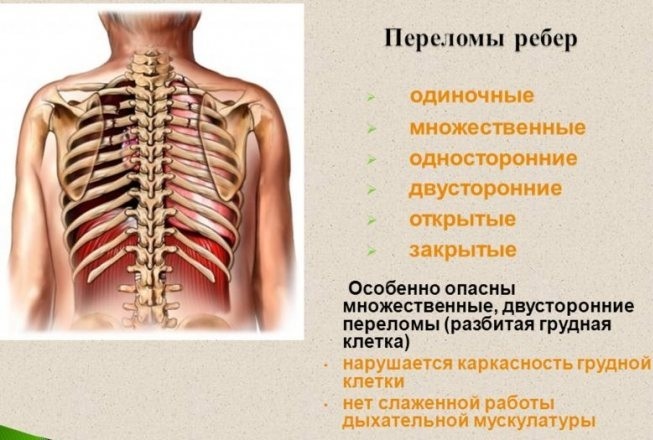
Depending on the severity of the fracture, the timing and stage of healing may vary.
Stages and degrees
Rib fracture (home treatment is possible with the standard type) occurs most often with mechanical injuries.
There are several main degrees:
- severe - long-term disability (3 months or more);
- medium - temporary disability (2-3 months);
- easy - disability for 3-4 weeks.
For a severe degree, the following types of fractures are characteristic:
- numerous - after injury, several fragments are formed;
- bilateral - fractures are formed on the left and right sides at the same time;
- one-sided - several ribs are broken on the left or right side.
The timing of fracture healing directly depends on the severity of the injury.
Regeneration stages:
- Stage I (formation of connective tissue calluses). It is characterized by the accumulation of blood at the site of the fracture. Fibroblasts accelerate the growth of connective tissue and the formation of calluses.
- Stage II (formation of osteoid callus). The blood transports minerals and other "building" elements to the fracture site, which penetrate into the connective tissue, contributing to the formation of osteoid calluses.
- Stage III (formation of hydroxylapatites). Bone components increase the strength of the osteoid.
To speed up the healing process, you need to limit your physical activity.
Symptoms
A rib fracture, which is prescribed by a doctor at home, is characterized by the appearance of specific symptoms.
Main clinical conditions:
- Painful sensations. The first symptom of a fracture. Pain occurs when nerve endings and soft tissues break. Rupture of muscle tissue is possible. If the patient is in a supine position, he experiences aching pain. When changing position, it becomes sharp. With a fracture, a person feels pain in the chest and under the scapula.
- Breathing disorder. The patient is unable to take a deep breath, which indicates damage to the lungs. Breathing becomes shallow.
- Taking forced poses. To reduce pain, the patient tries to clasp the chest or slightly tilt the body forward.
External manifestations of the fracture:
- swelling;
- bruises and bruises from a blow;
- deformation of the chest.
If the trachea or bronchi are damaged, air accumulates under the skin. In this case, there is a high risk of developing pleuropulmonary shock, which is characterized by shortness of breath, prolonged cough and numbness of the extremities.
Reasons for the appearance
A rib fracture (home treatment is possible if one bone is damaged) is formed as a result of pathological changes or mechanical stress.
Traumatic factors:
- Blows. Blunt trauma can cause a closed, complete, multiple, or single fracture. After the impact, a crack often forms on the surface of the bone, possibly damage to internal organs and tissues.
- Road traffic accidents. If a person was driving a car at the time of the accident, then the risk of chest injury is quite high. On impact, an open (bilateral, comminuted, multiple) or closed (complete, stable, unstable) fracture occurs. Impacted forms are also found. When hit, a pedestrian receives multiple complex asymmetric fractures.
- Falls. Striking a hard surface can cause bone fracture and soft tissue rupture. The type of injury is directly related to the speed and angle of fall. In this case, a closed longitudinal or transverse fracture is most often diagnosed.
Rib fractures and cracks occur as a result of injuries sustained during the performance of various physical exercises. An unplanned fall is possible. If there is a mechanical compression of the sternum, then the integrity of the ribs on the right and left sides is violated.
Pathologies that can provoke a fracture include:
- Hereditary diseases. Increased fragility of bones, abnormal development of the skeleton, congenital cleavage of the sternum can lead to rib fractures (mostly closed).
- Osteoporosis. Pathology affects bone tissue. It is characterized by a decrease in strength. Ribs become brittle against the background of calcium metabolism disorders.
- Oncological diseases. Fractures are caused by malignant neoplasms (including osteosarcoma).
- Arthritis of the rheumatoid type. The disease affects not only bones, but also connective tissue. Recovering from a fracture involves taking medications that contain calcium.
The type of fracture and its location depends on the force of the impact or the height of the fall.
Diagnostics
The specific picture of rib fractures makes it possible to diagnose the injury without difficulty if the person is conscious. The victim must be taken to the nearest medical facility, where he will be examined by a specialist. There are several main methods for diagnosing fractures.
- MRI. This is an auxiliary procedure that allows you to refute or confirm the presence of displacement, lateral or angular fractures, and a fracture of the bones in the back.
- Ultrasound. The procedure is assigned to children in order to determine the complexity of the fracture. Ultrasonography can detect damage to cartilage tissue or detect the presence of blood clots in the pleural area.
- CT. Computed tomography allows you to examine the damaged areas and identify abnormalities in the structure of the lungs and cardiovascular system.
-
X-ray. X-ray (posterior and anterior views) indicates the location and number of the fracture. If a person breaks the rib on the side, then a lateral X-ray is taken. The pictures will show collateral damage.

Before prescribing a particular examination, the doctor must carefully examine the patient and collect an anamnesis. He listens to the patient's complaints and palpates the chest. Radiography is considered the most effective diagnostic method: the method allows you to accurately determine the location of the injury.
The victim receives first aid in state medical institutions free of charge. In private clinics, additional services (MRI, CT) are provided for a fee. The cost varies between 3000-6000 rubles. (complex).
When to see a doctor
The reason for contacting a medical institution is the presence of at least one of the following signs:
- an increase in body temperature up to 38-39 ° C;
- fever;
- hemoptysis;
- harsh cough;
- pain in the forearm, abdomen, or chest;
- labored breathing.
The patient's well-being at the time of contacting a medical institution directly depends on how correctly the first aid was provided to the victim.
The algorithm of actions may differ depending on the type of injury. A person is given a drug that can stop pain attacks (Analgin, Diclofenac). In case of multiple fractures, the chest must be bandaged. The patient is helped to get rid of excess clothing.
With open fractures, the first step is to stop the bleeding. Wounds are treated with disinfectant solutions and a bandage is applied. Timely fixation of the fracture minimizes the risk of rupture of internal organs by fragments.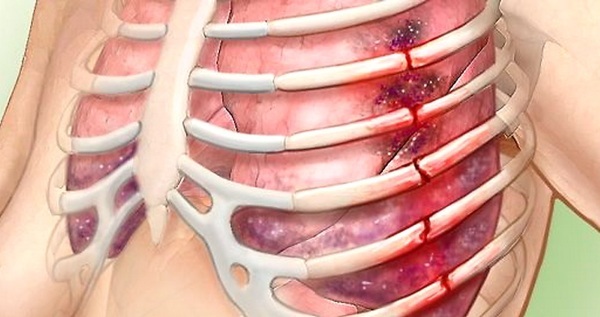
In case of a fracture, it is necessary to see a doctor immediately after an injury. The traumatologist will determine the type of fracture and prescribe appropriate treatment. In difficult cases, especially if several fragments have formed after a chest injury, surgery may be necessary.
Prophylaxis
Rib fractures occur not only as a result of mechanical stress. Some people inherit brittle bones from their parents. Osteogenesis imperfecta or the disease of the "crystal man" is transmitted from blood relatives.
There are no effective preventive measures against this pathology. Experts recommend that at the stage of pregnancy planning, calculate the risks and undergo examinations by geneticists on time.
Preventive measures against pathologies of an infectious type, leading to fragility of bones, include proper balanced nutrition and regular exercise. These activities are aimed at strengthening the immune system.
At risk are people suffering from:
- rheumatoid arthritis;
- infectious liver diseases (hepatitis, echinococcosis);
- oncological diseases.
To strengthen your bones, you need to eat foods rich in calcium. The diet should be dominated by dairy products, legumes, fresh herbs and nuts. Experts recommend taking vitamin and mineral complexes on a regular basis. The provoking factors include the abuse of alcoholic beverages and tobacco products.
Treatment methods
A rib fracture is a fairly serious injury that requires a visit to a specialist. Home treatment is possible if the injuries are uncomplicated. In case of violations of the organs of the cardiovascular system and respiration, a person needs hospitalization.
To speed up the healing process of fractures in a hospital setting, medical personnel perform the following procedures:
-
Applying a circular bandage. The patient, who for some reason cannot wear the plaster cast, is put on a squeezing bandage made of elastic bandage. The chest is pulled tight on exhalation.
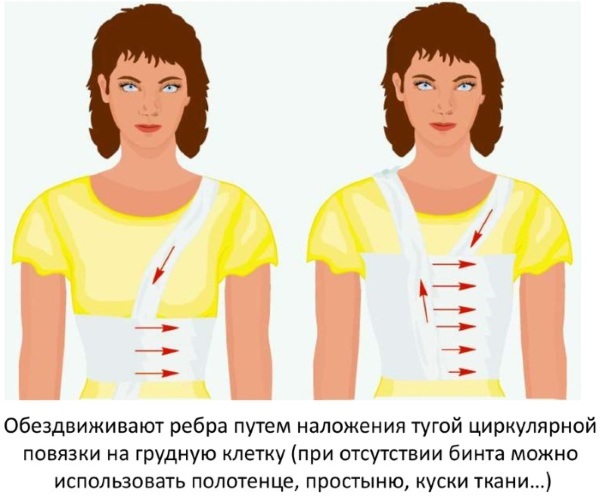
- Immobilization of fragments. The procedure is indicated for patients with a closed fracture. In this case, attention is paid to symptoms indicating displacement. Plates are used to form a rigid frame and hold the debris in position. The method is used for severe fractures, a person loses the ability to move independently for a long time.
- Anesthesia. If a person is experiencing severe pain, then he is given drugs that contain narcotic substances. It is forbidden to use them for a long period.
- Plaster application. To stabilize and fix the fragments in the desired position, a plaster cast is applied to the patient. The framework allows you to restrict movement, reduce pain and normalize breathing.
The rehabilitation period after a fracture is 20-60 days. The patient spends 2 weeks in the hospital, after which he is discharged and continues treatment at home.
Medications
Make up drug therapy. In the course of anti-inflammatory antiseptic and analgesic drug. For relax. Automation. Fracture. Extremely. In severe cases, the patient is given. Pain reliever.
With narcotic ingredients:
- Promedol. It goes on sale in the form of a solution. The main component is trimeperidine, which acts as a mu (opioid) receptor antagonist. The principle of action is the ability to change the emotional color of a painful attack, disrupting the transmission of impulses to neurons. The drug is characterized by suppression of reflexes and a sedative effect. The antispasmodic effect is moderate. The drug can be purchased by prescription, the price is 450-550 rubles.
- Morphine. The injection solution is administered subcutaneously. The main component is morphine (in the form of hydrochloride). An opioid receptor antagonist has a sedative and analgesic effect. The drug relieves pain, changing its emotional color. Refers to narcotic drugs. It can be purchased only with a prescription, the cost is from 420 rubles.
For fractures, the patient is prescribed analgesics.
The most effective are:
- Diclofenac. The drug has several forms of release (solution, tablets, ointment for external use). The active ingredient is sodium diclofenac. The drug has an anti-inflammatory effect, disrupting the exchange of arachidonic acid. Reduces the severity of pain. Available with a prescription. Packaging costs 50-90 rubles.
-
Nimesil. The drug is marketed in the form of a powder that is readily soluble in water. The main component is nimesulide. It has an analgesic and anti-inflammatory effect. Belongs to the group of sulfonamides. In case of fractures, the drug relieves pain and eliminates swelling. Purchased by prescription, the price is 180-230 rubles.
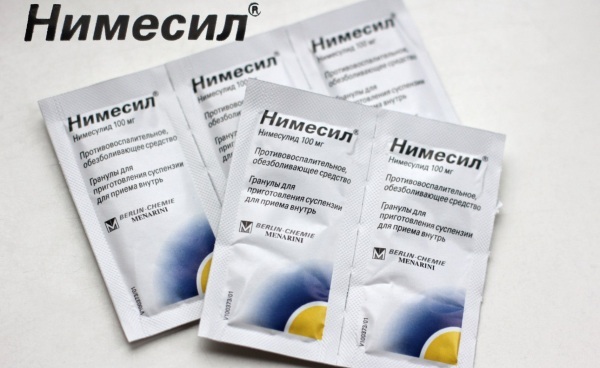
During the rehabilitation period after a fracture, the patient is prescribed to take vitamins and minerals to maintain immunity. The composition of drug therapy may include drugs that contain calcium. The course of application is selected individually.
Traditional methods
Traditional medicine for fractures is more gentle. They can be used concurrently with medications. Funds are classified according to the method of manufacture and use.
Allocate:
- tinctures;
- compresses;
- ointments;
- decoctions.
Popular recipes:
- Rosehip decoction. The composition of the drug contains vitamin C, which makes it possible to accelerate the process of bone tissue regeneration and strengthen the immune system. Ripe fruits (50 g) are poured with 100 ml of water. The container with the broth is placed on low heat, brought to a boil and boiled under a closed lid for 10 minutes. Insist means 24 hours. After it has cooled down, decant the broth and take 50 ml 2 times a day.
- Fir oil ointment. The product has a regenerating effect. In fir oil (20 ml) add chamomile flowers (5 g) and spruce resin (5 g). All ingredients are thoroughly mixed, the ointment is infused for 12 hours and applied externally for 3 weeks.
- Compress from budra. The product helps relieve swelling and stimulates the recovery of soft tissues after a fracture. Ivy bud (6 tbsp. l.) is poured with water (1 l). The container is put on fire, brought to a boil, boiled for 20 minutes, cooled and decanted. The resulting solution is blotted with gauze or bandage and applied to the fracture site. The course is 20 days.
- Tincture of comfrey root. The plant has a regenerating, antiseptic and analgesic effect. 10 g dry root pour 50 ml of vodka or alcohol. The container with the infusion is hermetically sealed and removed for 14 days in a dark place. The infusion is taken daily, 2 - 3 times a day, 15 - 25 drops once. The course is 24 days.
According to reviews, mummy helps with fractures. Tablets can be purchased at the pharmacy and taken as a stand-alone remedy or added to an ointment, after grinding.
Other methods
To enhance the effectiveness of drug therapy, physical therapy is often prescribed to the patient for fractures.
These include:
-
Hirudotherapy. For fractures, leeches are applied to a healthy area of the skin near the location of the injury. The patient feels relief after 24 hours: the pain becomes less acute, the joint is restored. Leech saliva contains components that can thin the blood, which minimizes the risk of clots. The regeneration process is accelerated by restoring normal blood microcirculation in the affected area. The course is 30 days.
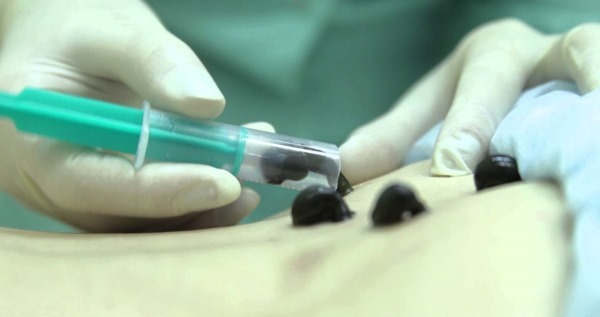
Leech therapy is only an adjunct treatment for a fractured rib - Electrophoresis. For fractures, patients are prescribed ionogalvanization with calcium. The procedure speeds up the healing process of bone tissue and the formation of soft calluses. Electrophoresis can be performed 72 hours after injury. The procedure lasts 15 - 20 minutes. Sessions are daily, the course is up to 15 days.
- Magnetic therapy. The procedure has a decongestant, anti-inflammatory and analgesic effect. In combination with the above-described methods, magnetotherapy promotes faster recovery of bone tissue after a fracture. A magnetic sensor is fixed on the affected area. The program is set by a specialist, choosing the range of the field effect (no more than 4 cm). The session lasts 30 - 45 minutes. The course is up to 15 sessions. The procedure is repeated 2-3 times a week.
- Ultraviolet irradiation. The procedure improves the repair process, providing anti-inflammatory and analgesic effects. UFO is carried out every 2 days. The initial dose is 2 units. The course includes 20 sessions. The procedure is prescribed 9-10 days after the injury.
In addition to physical therapy, the methods of treating fractures include physiotherapy exercises. The patient should regularly work the affected area by doing hand exercises.
Possible complications
Untimely or poorly provided first aid to a person with a fracture can lead to the development of closed pneumothorax. Local pathology is characterized by the accumulation of air in the pleural region.
The patient's skin acquires a bluish tint, he complains of a hacking hacking cough, heavy breathing and enlarged veins in the neck. To get rid of air accumulation, a puncture is required in a hospital setting.
Fragments formed after a fracture provoke the development of hemothorax. In this case, blood accumulates in the pleural area.
Signs of pathology:
- lowering blood pressure;
- tachycardia;
- lack of vesicular respiration.
The blood is pumped out in the hospital, and drainage is installed there.
A rib fracture, accompanied by violations of the integrity of the bones, can provoke a hereditary disease, fall or severe blow. Home treatment is carried out in several ways.
It is strictly forbidden to self-medicate, the doctor is responsible for the selection of drugs.
Rib fracture video
Symptoms and signs of rib fracture:



